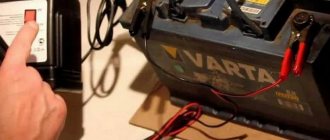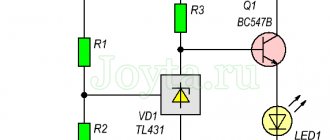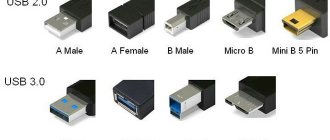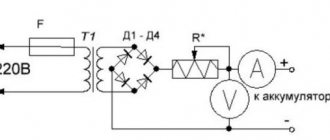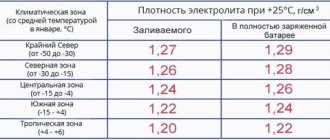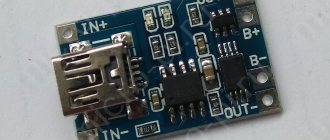A car battery consists of 6 cells connected in series. Each bank has a full charge of 2.10-2.15 V, so the total voltage is summed up and is 12.6 - 12.8 V. What is the voltage of the battery after the charger is turned off? When installing the battery in a car, the voltage after charging should be 12.4 V. This is normal. The car's starter battery is discharged during engine startup and, while driving, it recovers energy from the car's generator. If the battery voltage drops to 12 V, the device requires charging from the network. A large loss of charge in banks is characterized as a deep discharge that destroys the battery.
Safety rules when charging a car battery at home
It is permissible to charge a car battery only if all safety rules are strictly observed. Charging time can be up to 10, depending on the specific device and the battery itself. In most cases they are rated at 60 amps, but there are models that deviate from the standard.
The room must be ventilated and there should be no proximity to fire or sparks. In this case, charging should be constantly monitored. During connection, the plugs are unscrewed.
It is much better to initially protect yourself and use another room to charge the battery. This could be a garage, or you should contact a professional car service, where the entire process will be carefully monitored and will ensure careful and complete charging. If such options are not considered, then you should take into account the safety rules and follow them without any discrepancies. Otherwise, there may be an accumulation of gases from the electrolyte, an explosion as a result of an accidental spark, or the process will not have any result at all and you will have to turn to professionals for charging.
General principles for charging lead-acid batteries
Experts recommend using charging conditions for the battery in which a sharp decrease in current is clearly expressed at the end of the process. In practice, several methods are used, each of which has its own difficulties and is accompanied by different amounts of financial costs.
The most accessible and simplest method is considered to be direct current charging at a voltage of 2.4 - 2.45 volts/cell. The charging process continues until the current remains constant for 2.5-3 hours. Under these conditions, the battery is considered fully charged.
Deciding how to charge the battery is not difficult. Another question is what result will be obtained from using this or that method
Meanwhile, the combined charging technique has gained greater recognition among motorists. In this option, the principle of limiting the initial current (0.1C) until the specified voltage is reached.
The process then continues at a constant voltage (2.4V). For this circuit, it is permissible to increase the initial charge current to 0.3 C, but no more. It is recommended to charge batteries operating in buffer mode at low voltages. Optimal charge values: 2.23 – 2.27 volts.
Deep discharge - eliminating the consequences
First of all, it should be emphasized: restoring the battery to its nominal capacity is possible, but only under the condition that no more than 2-3 deep discharges have occurred. The charge in such cases is performed with a constant voltage of 2.45 volts per jar. It is also allowed to charge with a current (constant) of 0.05C.
The battery restoration process may require two or three separate charge cycles. Most often, to achieve full capacity, charging is carried out in 2-3 cycles.
If the charge is carried out with a voltage of 2.25 - 2.27 volts, it is recommended to perform the process twice or three times. Since at low voltages it is not possible to achieve the nominal capacity in most cases.
Of course, the influence of ambient temperature should be taken into account during the restoration process. If the ambient temperature is within the range of 5 – 35ºС, the charge voltage does not need to be changed. Under other conditions, the charge will need to be adjusted.
Consequences of deep battery discharge and how to properly charge the battery after this
The battery charge may reach zero. In this case, sulfite clogs the plates. This leads to a decrease in capacity. If you need to charge a car battery after a strong discharge, you need to select a voltage of about 16.2V, as well as a current of up to 1A. In this mode, it becomes possible to partially restore the battery plates. Among other things, due to a completely discharged battery, the car alarm may not work, and you will not be able to get inside. By
Charging a severely discharged car battery
If a lead battery is deeply discharged, then it can also be “reanimated”. In this case, part of the capacity will be irretrievably lost, but the battery will still work. The easiest way to do this is with a charger, if they have a pre-charge option. It involves charging up to 12 V, after which the standard mode is turned on.
In the normal mode, the battery cannot be charged during deep discharge, as this will lead to overheating of the plates. When recharging, the current is supplied with pauses, and its strength is lower than usual.
How to charge the battery
A standard 60ah battery will be charged effectively using the basic rules. The procedure must be performed at least 2 times a year to increase the service life of this car part. It is best to recharge to full before and after winter, because it is during the cold season that such a battery wears out the fastest. This process is included in regular maintenance, but is not required. It is best to first measure the charge level and draw conclusions based on your research.
The charging process itself occurs using a special device. It can be different, from a simple adapter to an automatic complex option that will fully control the entire process. It is possible to set certain voltage and current indicators; there is an accurate indicator that allows you to understand when the procedure can be considered complete.
It is important not to use the battery immediately after charging. It needs to be given some time, about an hour, for the battery to just sit and all the processes inside it to normalize. Then the battery is tested at rest and under voltage to draw conclusions about the charging result.
How to properly charge a car battery with a charger
It is important to follow basic safety precautions and constantly monitor the charge level. For this, a suitable charger is used, be it a 6,12,24A option. Before installation, be sure to unscrew the plugs; you may need to change the electrolyte. Depending on the type of battery, the principle of the algorithm itself changes.
The main rule in charging a battery is not to rush. In an emergency, using special wires, you can simply light a cigarette from another battery from the car, and then slightly increase the charge while driving. However, this will not be a solution to the problem, it is just a way to get home if the driver is far from the parking lot. Full charging requires careful preparation, you need to devote enough time to it and constantly monitor the process using special measurements and regular monitoring to ensure safety and achieve the desired effect.
How long does it take to charge a car battery with a charger?
It takes about 10 hours to charge a car battery. This process can be accelerated by significantly increasing the voltage and current, but such an emergency process will be very harmful to the battery.
Charging a car can be done in at least 2-4 hours. This occurs due to a significant increase in voltage and current. Indeed, this seriously speeds up the process and helps restore energy in a very short period of time. The use of such a procedure seriously damages the battery; the time can really be reduced only in cases where the situation is urgent and should not be repeated often. With each cycle, the capacity will decrease, and the battery will fail very quickly.
How long to charge a battery with direct current?
The charging current of a car battery should be the lower, the better. It is necessary to strictly limit it in order to control the wear of the battery and prevent it from deteriorating. It is most effective to automatically arrange certain swings with a decrease and increase in current strength. However, if this is not possible, it is best to make the indicator as low as possible. Of course, such an approach will significantly extend the charging time itself, but the basis is precisely a careful attitude towards the battery, and not at all the need to charge it as quickly as possible. For speed, there are other relevant options used in an emergency.
How long does it take to charge a car battery with constant voltage?
The battery charging current is not the only criterion. You definitely need to pay attention to the voltage. If constant is used, then charging should be based solely on the basic order, which is indicated in the instructions. Restrictions vary for different models. In fact, the charging process can take about 4-6 hours. This is quite harmful for the battery, but at low DC voltage it is not a critical problem.
Intelligent charging for car battery
Intelligent charging for a car battery is a device that replenishes its losses with minimal participation of the car owner.
There are two types of devices:
1. Transformer. They are quite heavy, have a manual control mode, and are able to charge the battery quickly and efficiently.
2. Pulse or inverter. These are truly smart devices that have a large list of functions. They can start even a very discharged battery, and the charging process does not require control.
The chargers, which are equipped with a controller, themselves determine the type and capacity of the battery, what current and voltage it requires. Based on this, the device will select the optimal option for parameters and save them in memory. This charger also has a desulfation function to extend the battery life.
How to properly charge a car battery
During the procedure, you must choose the right charger and follow the basic algorithms of the procedure, only in this case it will be quite productive at home. Also, do not forget about the density of the electrolyte in the battery.
- It is necessary to unscrew the plugs or read the instructions in detail if they do not come out.
- Connect the red wire to the positive wire and the black wire to the negative wire.
- After that, connect the device to the network.
The correct approach is to charge slowly and choose a quality device. The ideal option would be a 12V option, it is better if the model is automatic. It will show the charge level and indicate when you can disconnect from the network.
Is it possible to charge the battery in a car?
The battery charge may run out unexpectedly, in which case you may need to charge it directly on the car. This process is harmful to the battery and quite dangerous. Sometimes there are simply no other options.
The bottom line is that another driver connects a dead battery to a charged one using special wires. Such recharging occurs quickly; it is important to monitor the condition of both machines. In most cases, a few minutes is enough. After this, you should get to a car service center and fully restore the battery. This option can be considered an emergency when you only need to recharge the battery for a short time in order to use it on the road.
How to charge a calcium battery
Charging the battery should only be done with a high-quality device on which you can set the voltage. It should be 16.1V. In the future, you need to follow a specific algorithm:
- The mode is maintained until the car battery is charged to 10%.
- After this, the upper mode is set to 16.1V and 3A, and the lower mode to 13.2V and 0A. This is a smooth swing that allows you to restore capacity.
- Switching is done automatically, the intervals gradually decrease.
This system is perfect for a calcium battery.
How to charge a hybrid battery
A common question is how to properly charge a hybrid battery. There are several useful tips that will help you carry out the process efficiently and correctly.
- Initially, the current should be set to 1/10 of the rated value.
- The initial voltage is around 13.8 and then it increases to a maximum of 14.4.
- It is best to use low currents of about 3A.
With this careful approach to charging, it is easy to extend the life of the battery and ensure its stable operation.
How to charge amg battery
In this case, the algorithm is very simple; it must be followed if you plan to use the battery for a long time and not spoil it with the charger:
- Initially, the battery current is selected at 10% of the capacity of the entire battery according to the manual.
- You need to recharge in this way before the voltage at the terminals reaches about 14.3V.
- After this, it is necessary to set the current 2 times less.
This procedure takes about 10 hours, but it is the most effective and high-quality for the battery.
What happens if you charge with high current?
Some car enthusiasts, in order to save time, charge the battery with a high current. This error can occur if you turn on the battery, set it to a certain value and stop monitoring the process, for example, leave the garage. As the density of the electrolyte increases, the current may increase excessively.
First of all, high current can lead to failure of the charger, even to the point of ignition. Therefore, it is impossible to install starter-chargers on easily flammable tables and stools.
At high current, the temperature of the electrolyte increases. It may boil. If the electrolyte boils, water evaporates first. Concentrated acid remains in the jars, which destroys the plates. This way you can completely lose the battery.
The most terrible consequence of high current is the explosion of a battery bank. More than one battery worker received chemical burns as a result of a battery explosion. Therefore, it is necessary to stop the operation immediately if the electrolyte boils!
How to determine the battery charge level
It is possible to check the battery itself before charging. To do this, it is enough to have a multimeter. The steps are very simple:
- The voltage mode on the device is set to 20V;
- The voltage on the battery is measured at rest and under load. For the second measurement, you need to start the car and then take measurements;
- Normally, the readings should be 12V during the first experiment, and drop to 9V during the second.
If the results are less than normal, then you definitely need to charge at home or contact a car service for this procedure. A low battery charge is indicated by a corresponding icon on the dashboard.
Measuring the voltage at the terminals without load
Without load, the voltage value is always measured first. When it comes to a simple passenger car, the standard is 12V. In the case of motorcycles, it is reduced to 6V. The result of 24V can be found on trucks, and this voltage is constantly used in a variety of special equipment.
Measuring electrolyte density
During the battery examination process, the electrolyte must be checked periodically. The main indicator is the density of the substance. It is examined using a load fork. In fact, you need a densimeter or a densimeter
To obtain an accurate result, it is necessary to control the temperature; it should be about 25 degrees, otherwise distortions are possible. It should be taken into account that the electrolyte’s density normally shows 1.28 g/cm3. In the event that the indicators differ from the norm, charging is necessary. This is an indirect way to understand the battery level.
Voltage under load of vehicle electrical equipment
A charged battery must be tested not only at rest, but also under load. To do this, just start the car and wait a few seconds. In this mode, the voltage should drop, but not less than 9V. A reduced indicator may mean that charging is definitely needed. He cannot be any higher.
According to the built-in hydrometric indicator
A modern battery has its own indicator. It shows the charge. Data can only indicate an approximate level; often the actual figure is lower or higher.
In fact, it is important to use this option in situations where an hour-long charge is used or a cigarette is used from another car. This is an emergency option necessary to bring the car back to life.
▍ Drip precharge with pulsating current
Let's start restoring our battery. Pendant-912 is equipped with a pulse precharge function. The expediency of this stage is due to the fact that deeply discharged, i.e. An unbalanced battery, when supplied with a standard current of 10% of the capacity, can become very hot, since different sections of the plates will receive different current densities, and different banks will receive different overvoltages.
To avoid this, we set the current to 5% of the rated capacity, for 60 A*h this is 3 A. We make the pulse and pause durations equal, 5 seconds each. Completion of the stage upon reaching the voltage in the pause, i.e. NRC 12 volt.
How to charge the battery at idle speed
It is possible to charge the battery not only with the help of other drivers or chargers, the car owner can do it himself using the vehicle. To do this, you should stop, start the car and wait at idle for a while.
Before the process, it makes sense to check the voltage in the terminals; charging will take place if the voltmeter shows data of about 13.5V or higher. If the indicator is less, then the battery simply does not consume charge. In this case, it is also possible to get out of the situation by slightly pressing the gas pedal.
Of course, this option must be considered only from an emergency point of view. At the same time, understand that it will be impossible to replenish energy quickly enough. All major electrical appliances should be turned off if possible, such as the cigarette lighter, radio and on-board computer. Wait about 30 minutes minimum, and then do not forget about the need for high-quality, full charging.
How long do you need to drive to charge the battery?
It is not necessary to stand while charging the battery. It will charge perfectly while driving. It makes sense not to accelerate in one place, but just to ride. The trip must be at least half an hour in order for the energy in the battery to be replenished.
In winter, you definitely need to take it for a short drive before parking overnight with a low battery. Only in this case will he be able to park overnight and start the car in the morning.
Why is it important to set the charge current correctly?
The battery charging current is a defining characteristic of the charging mode. In the generalized case, it is the concept of charge “mode” that should be considered. Several types of batteries are used in cars with internal combustion engines:
- Acidic (antimony, calcium, etc.);
- AGM batteries;
- Gel.
Each of these types requires its own charging mode. For example, an AGM battery is fully charged in three stages:
- Main charge.
- Recharge.
- Final charge and preservation.
A conventional battery is charged in a single-stage mode. Deviation of values from standard values can lead to:
- reducing the effectiveness of the operation;
- loss of consumer characteristics;
- destruction of the battery.
How to charge a battery in the cold
In winter, every car enthusiast must take care of the battery. Before the start of the season, it is imperative to check the wear of the generator, the battery itself, and also clarify the charge level using qualitative measurements.
In winter, it is imperative to control the discharge process, otherwise every driver may find himself in an unpleasant situation when in the morning it is simply not possible to start his vehicle. Regular evening check-ins would be ideal. According to research results, it is possible to charge directly in the car, driving for about half an hour, as well as remove the battery and directly restore the energy in it using a good charger.
The driver must control his car completely, including knowing about the individual characteristics of the battery, as well as ensuring a stable charge level.
What happens if you charge with less current?
A small charge proportionally increases the recovery time of the battery capacity. In some cases, it is not possible to charge with the required current. Most non-professional chargers are designed with a maximum rating of 5 Amps. A battery with a capacity of 100 Amp-hours will take 20 hours to charge, that is, a day.
The good news is that small amounts of charge do not harm the battery. On the contrary, there is an ancient method of battery restoration. First, it is charged for a long, long time with a small value of 1 Ampere, then quickly discharged with extra current.
Discharged battery voltage
A battery whose terminal voltage is less than 11.6 volts is considered completely inoperative (discharged). In such a situation, the operation of an automobile energy source is impossible: the electrical equipment of the car will cease to function. That is, the battery needs to be charged.
A full discharge seriously affects the condition of lead batteries, which are especially sensitive to this problem. For such a battery to lose more than half of its capacity, just one deep discharge is enough. Batteries that contain antimony are more resistant to strong discharge. The same can be said about gel and AGM products. It is recommended to prevent the battery from being completely discharged, which will negatively affect its service life.
The winter period is worth mentioning separately. At this time, due to the slowdown of chemical reactions, the activity of the electrolyte decreases, which is fraught with its freezing. To prevent such an incident, it is recommended to maintain the voltage of a charged car battery and not allow it to drop below 12.5 V.
General points
The electromotive force is responsible for the normal flow of current through the circuit and gives a programmed difference in the output parts of the power source - that is, the battery. The required value will be calculated as the potential difference.
The electromotive force is equal to the energy spent on charge transfer between the terminals. The values of current forces and voltages are inextricably linked with each other. When this force does not occur inside the battery, there is no current at the output parts.
It is also important to understand that with EMF, there are volts even without current passing through the circuit.
When the circuit connections are opened, there is no current, but an electromotive force begins to be excited in the battery, and movement appears in the terminal area.
Volts are used to measure both quantities. The total electromotive force in a car battery develops as a result of electrical and chemical processes occurring inside it. The EMF is always greater than the voltage in the battery by an amount equal to the drop in the internal voltage.
Voltmeters and multimeters are used for measurements. In a car battery, the dimensions of the EMF will depend on the density and temperature values of the electrolyte.
If the density of the electrolyte substance increases, the current indicator, EMF, also increases.
There is no exact information on what is the ideal value for a battery. Experts take into account the optimal starting parameters for starting the motor mechanism. If the battery is new and charged, this value should be 12.6–12.7 volts.
If the voltage of a charged car battery without a load is higher, this does not indicate a problem.
For example, immediately after charging the battery, its current during measurements will be 0.5 volts higher than the real one, and this must be taken into account in the final calculations. 13.0–13.2 volts is a figure that exceeds the permissible voltage values, but for some battery models it is normal.
The battery shows data close to the recommended values a couple of hours after charging.
12 volts or less is considered critical for the battery. If the value is less than this figure, urgent charging is needed. It is impossible to use the battery at its resource limit, since in this case the process of sulfation of the plates will start. In the future, it will be problematic to get rid of the effects of sulfation, and you will have to buy a new battery.
At the same time, 12.1 volts is enough to start the engine; problems arise at 11.6 volts and below. These are all numbers that you need to know about and take into account while working. In most cases, the voltage of a charged car battery is around 12.2–12.5 volts.
Charge table
In order not to miss the moment when the battery charge drops to an extremely critical level, use the battery charge table. If you measure U at the terminals, you can calculate the total charge.
Also in the table you will find the values of electrolyte density and temperature values at which it can freeze in winter. You can familiarize yourself with the main values in the table of car battery charge by voltage.
▍ Main charge stage
The main charge settings are standard for a hybrid battery. The maximum voltage is 14.6 V, the current decrease begins at 14.5 V, the current is 6A, this is 10% of the capacity. But let’s also include asymmetry (reverse): the discharge current is 10% of the charging current, i.e. 0.6 A, charging pulse duration 5 seconds, discharge pulse duration 50% of the charging pulse.
Discharge pulses with an asymmetric (reversible) charge partially remove polarization, thereby increasing the efficiency of charging and desulfation. Some adaptive memory devices, in contrast to classical ones, including programmable ones, use a discharge pulse to analyze the response of the electrochemical system. Discharge pulses, like charging ones, can be modulated, i.e. be packets of shorter pulses and pauses, which allows you to study the internal resistance of the battery at a different frequency.
The end of the stage after 6 hours at the set voltage achieved. It is difficult to predict what the current will be at the end of the main charge. Therefore, it is good that the memory provides such an automation option. We will not activate the recharging and storage stages yet. First, let’s check what the precharge and main charge will lead to with these settings.
The charge lasted 19 hours 34 minutes, the battery received 57.53 Ah. This number gives hope that the battery has not experienced a significant loss of capacity after a deep discharge.
The density of the electrolyte in the banks is from 1.23 to 1.25, which is clearly not enough. There is electrolyte separation and recharging is required.
The tester shows TCP 501 out of 520 A, battery health (SoH, state of health) 96%. These are good indicators, the battery will still serve, but we must take into account that an undercharged battery has a slightly lower internal resistance than a 100% charged one. Now it is 6.20 milliohms.
